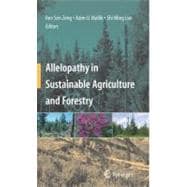
Note: Supplemental materials are not guaranteed with Rental or Used book purchases.
Purchase Benefits
What is included with this book?
| List of Contributors | p. ix |
| List of Reviewers | p. xiii |
| Introduction: Allelopathy Research and Application in Sustainable Agriculture and Forestry | p. 1 |
| History | |
| Historical Examples of Allelopathy and Ethnobotany from the Mediterranean Region | p. 11 |
| Allelopathy: Advances, Challenges and Opportunities | p. 25 |
| Allelopathy in Chinese Ancient and Modern Agriculture | p. 39 |
| Allelochemicals and Allelopathic Mechanisms | |
| Allelochemicals in Plants | p. 63 |
| Allelopathy: Full Circle from Phytotoxicity to Mechanisms of Resistance | p. 105 |
| Allelopathic Mechanisms and Experimental Methodology | p. 119 |
| Indirect Effects of Phenolics on Plant Performance by Altering Nitrogen Cycling: Another Mechanism of Plant-Plant Negative Interactions | p. 137 |
| Genomic Approaches to Understanding Allelochemical Effects on Plants | p. 157 |
| Allelopathy from a Mathematical Modeling Perspective | p. 169 |
| Application of Allelopathy in Agriculture and Forestry | |
| Progress and Prospect of Rice Allelopathy Research | p. 189 |
| Rice Allelopathy Research in China | p. 215 |
| Recent Advances in Wheat Allelopathy | p. 235 |
| Sorghum Allelopathy for Weed Management in Wheat | p. 255 |
| Allelochemicals in Pre-cowing Soils of Continuous Soybean Cropping and Their Autointoxication | p. 271 |
| Autotoxicity in Agriculture and Forestry | p. 283 |
| Black Walnut Allelopathy: Implications for Intercropping | p. 303 |
| Plant Growth Promoting Rhizobacteria and Mycorrhizal Fungi in Sustainable Agriculture and Forestry | p. 321 |
| Utilization of Stress Tolerant, Weed Suppressive Groundcovers for Low Maintenance Landscape Settings | p. 347 |
| Allelopathy in Forested Ecosystems | p. 363 |
| Index | p. 387 |
| Table of Contents provided by Ingram. All Rights Reserved. |
The New copy of this book will include any supplemental materials advertised. Please check the title of the book to determine if it should include any access cards, study guides, lab manuals, CDs, etc.
The Used, Rental and eBook copies of this book are not guaranteed to include any supplemental materials. Typically, only the book itself is included. This is true even if the title states it includes any access cards, study guides, lab manuals, CDs, etc.